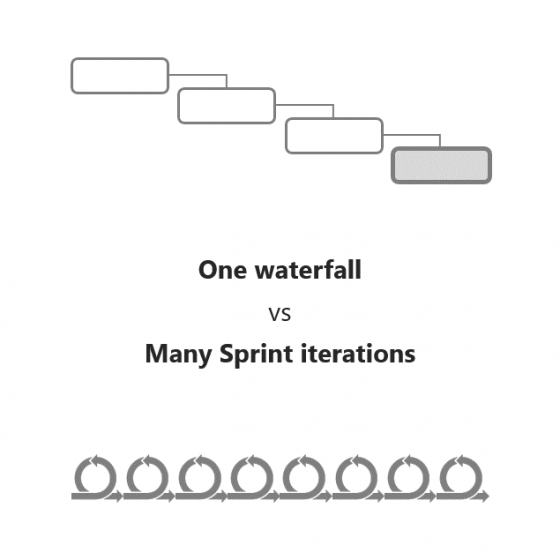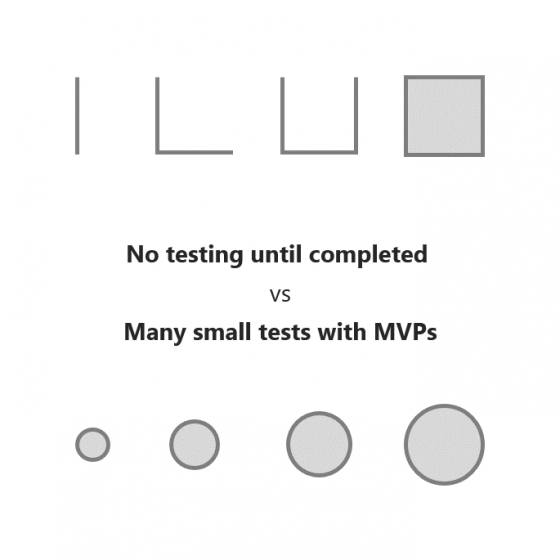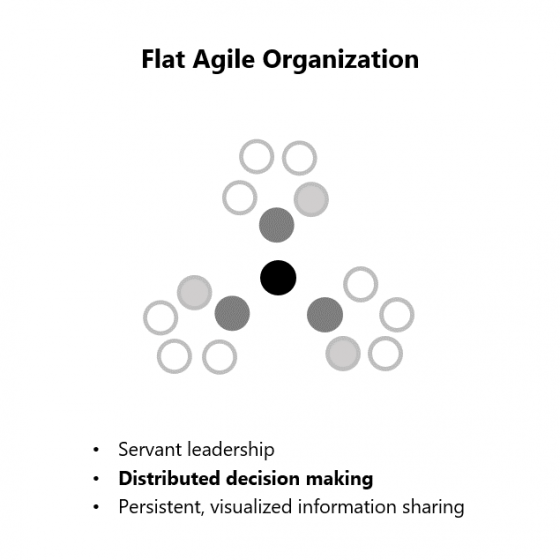
Terminology: Lean, Agile, Scrum, Sprint, Kanban
- Consider Lean & Agile to be quite similar, basically they are really good approaches to handling projects with lots of uncertainties, which is why successful startups take the lead. it’s France. (For the actual history of the origins of Lean, Agile and Scrum, refer here .)
- Scrum and Kanban are the two most popular Agile project management frameworks. They differ quite a lot – Scrum seems to be used more and pure Kanban is less. But in reality, everyone uses their own modified version of Scrum, which is encouraged and often uses Kanban elements (so do we).
- Sprint is a term of Scrum. It is an iterative cycle in Scrum.
- Therefore: Lean ≈ Agile> Scrum> Sprint
Why Lean & Agile?
Because in the changing world of Social and Digital engagement, we need a better way to do Business and Managing organizations.
Lean & Agile is an antidote to two main causes of dysfunction in modern organizations.
- Waterfall Project Management , and
- Functional organizational hierarchy .
Project Management Waterfall and Agile


When we think about project management, most of us imagine a disciplined, step-by-step approach to good planning and setting clear goals. This is essentially a Waterfall project manager.
Waterfall project management thinking is deeply rooted in our culture. Our education also emphasizes good preparation and prudence in every step. Progress is met the points on the Check Point. Being on the right track gives us comfort and confidence, and it also makes monitoring and management easier for our teachers and leaders. It is a good approach. Many modern masterpieces in the world would not exist without Waterfall. Businesses around the globe have successfully expanded with Waterfall. But Waterfall has its limitations: It works well in naturally repetitive projects and is relatively low uncertainty.
In fact, the world is full of uncertainties. It is very difficult to predict human behavior. And in a project where you are developing a product that has yet to find a market, managing Waterfall project is a very expensive way to find a niche for the product market. There is only a limited number of times you can remove and rebuild products, and the time required to undergo a product build iteration in Waterfall puts you at a disadvantage compared to the competition. pictures.
Agile emerges as a solution against Waterfall’s shortcomings. It’s a faster, more cost-effective, and less risky approach for businesses to deal with uncertainties around in their Business. And in this fast-paced digital transformation world, it’s not just startup companies that have to deal with market disruption. Businesses of all sizes in industries need a better way to deal with change, and Agile is a solution.
Traditional organization structure and Agile


Delegating work is a daily challenge for the Leader and Manager. The culture of Team handover creates obstacles against pursuing higher goals of the business. Agile basically addresses these organizational challenges with a redefined model of Teamwork and Leadership.
In the traditional organization, the Leadership and Management Team are responsible for making decisions – for strategy and problem solving, the expected answers come from above. This poses a great risk to the Leader “in having to make the right decisions”. However, once again, in the rapidly developing age of Digital and Social, very few people have fully converged all the elements. Recognizing that problem-solving is an exploration process, Agile encourages the creation of hypotheses and tests that are like an exercise for all organizations. Put simply, simply putting multiple eyes and collective intelligence increases the chance of “getting the right things”.
Spirit of Lean & Agile
Lean & Agile is an approach, not a method. Even Scrum, an Agile implementation framework, denies a method. Measuring is because there is no rigid method that solves the problem against uncertainty. Instead, you follow certain general principles, or can be summed up like the spirit of Lean & Agile, and strictly apply it:
- Constantly pursuing products that are suitable for the market (= Providing real value to customers) as an effort of the entire organization.
- Build, measure, learn : accept uncertainty – that’s why we hypothesize, test, and validate to see if we’re getting closer to what our customers really are. like it or not. Follow small steps and keep repeating until it is fixed.
- It is everyone’s job to understand customers, not just Sale & Marketing or Leadership Team. It is not someone else’s job to think about customers – It is also your job. Therefore, you are allowed and encouraged to Run a “Build – Measure – Learn” experiment with customers (even if you are not directly facing customers), and the Leadership Team will create sue, as a Servant Leader, a Framework for systematic working collaboration.
- In Lean & Agile, no one is reprimanded. If there is a failure, we are not looking for someone to blame, instead we examine the system that created the error and fix it.
Implement Scrum
Decentralized Vision
First, your business vision needs to be shared with everyone in your organization as a “connection” way: everything that people do, up to the task level of their personal affairs, needs to be reconnected. with Vision.
This is harder than we expected. Leadership can speak and present about Vision, but it is not necessarily agreed upon by everyone. The Vision sharing exercise is really a Vision formation exercise with who you are.


Enter Scrum: Epic, Story, Task are Scrum terms, which help people think about all the important things in a product or project that need to be built or implemented to realize a common Vision. By design, Scrum places people on the same page by practicing creating a “Backlog” along the Vision hierarchy.
Running Sprints
Scurm is a “time-bound” project management framework with sprints, where you set a fixed period of the work cycle, usually from one to four weeks, according to the work’s characteristics. Your team. (Kanban is also another popular Agile project management framework, a “capacity constraint” approach.)
The idea is to do everything in small steps and repeat quickly, with an emphasis on reviewing work to help Team reach the goal. Constructing hypotheses and repeating testing is an integral part of Scrum, as most projects face uncertainty, and discovery is key (Marketing is a prime example – The product itself is suitable for the market is an exploration process).

1. Backlog
Think about everything in the product or things that need to be done in the project. Step on the User’s journey: User Story is a great way to contextualize customer desires and needs.
User Story: As a [user], I want [what], so that [value].
2. Sprint Planning
Set priorities and evaluate Backlog, decide what to do in the next Sprint.
- To estimate the time required to complete each Job, Planning Poker is a useful tool.
- Kanban Board (or Scrum Board) is the main Item in Scrum. This is where information is constantly displayed, visualized and shared with the Team. Encouraging customizations to fit in with Team Workflow.
- Definition of Done is a must-follow in Scrum. Definition of Done is not just a quality assurance concept for Sprint Team members to verify work before Release. It is also a measurement and learning criterion for many hypotheses and test trials in Sprint.
- There are two roles of Leader coordination in Scrum. The first is the Product Owner , the “what” guy, and the second is the Scrum Master , the “how” guy. The key is coordination – the productivity of the Scrum Team is measured by the velocity (speed) , or the speed at which they can get the job done, and the most effective way is to facilitate team members, to individually and collectively make decisions about what to do and how to do the work, rather than guide them like in traditional organizations.
3. Daily Stand Up
A typical Scrum Team should be between 3-9 people , including the Product Owner and the Scrum Master. If larger, the speed of the Team decreases, so it is best to divide into different Scrum Teams.
The key to speed is the rich communication between Team members about progress and obstacles. Daily Stand Up with fixed form proved to be effective for this purpose: Every day at the same time , under 15 minutes , the whole Team rallied before Kanban Board, and each Team member would share the progress. by answering the following 3 questions:
✓ What did you do yesterday?
✓ What are you going to do today?
✓ Are there any obstacles in the process?
In addition, the Team can also look through the order of the Done or Todo items on the Kanban Board. It is a better way if there are more members in the Team participating in each Item of Kanban Board.
Daily Stand Up is not a meeting to update the status of the Manager to find out who is behind schedule or guide their work. Updating status only provides Snapshot – The important thing is to check Flow. Stand Up is for the Team to understand what has been completed and what is left, so that everyone can speed up Teamwork work. If someone is stuck, Team members can come and help. And if necessary, the Scrum Master will adjust the Work Flow to facilitate obstacles removal.
4. Sprint Review and Retrospective
At the end of each Sprint, the Scrum Team conducts two Meetings.
The first is the “what” Meeting: The Sprint Review looks at what has been done in the last Sprint, and is coordinated by the Product Owner. This meeting is usually accompanied by new Release Demos and other achieved achievements, and the rest of the organization is welcome to participate.
The second is the “how” Meeting: Sprint Retrospective. It’s time for Scrum Team members to reflect on and discuss the hurdles that sprung up during the last Sprint, even when things are going well, ideas for improvement. The Scrum Owner facilitates this Meeting by focusing the rest on fixing process errors rather than blaming others.
At the end of both meetings, Team updates Backlog and plans for the next Sprint.
Common Scrum pitfalls
‣ Scrum without a soul: Sprint is like a Mini-Waterfall
Often, User Story becomes small specification documents. With that, Coding or turn on any operations to be performed, then UAT (user acceptance testing) or other … process. At first glance, this may not sound wrong, and many Teams fall into this trap.
The problem is, this is just about running a small project in a miniature Waterfall style. Analysis, Design, Coding and Testing are done in a sequential manner, which can take many sprints and is likely to be a transition between functions (e.g. BA (Business Analysis)> Developer > QA (Quality Assurance)).
Lean & Agile is on the side examination to combat uncertainty. In Scrum, the “Build – measure – learn” cycle is designed to happen during a Sprint, and Team members work on hypothetical, MVP (Minimum viable product) building and Testing that need to work and Close. issue as soon as possible together; ie multi-functional Teamwork. The work is not sequential – if something doesn’t work or lacks a key point, it’s perfectly okay to change the design and modification, or make a conscious decision to follow. different access; ie fine-tuning and mini-pivoting. Small Waterfall undermines the purpose of repetition and only gains the small benefits of Scrum.
‣ Local scrum
Agile is now a popular place among software development teams. The problem is, in many organizations, it’s just a Development Team running Run Scrum, resulting in an island in the organization.
The result is a culture of transition between the Development Team and the rest of the organization, such as the Sale Team: “We have incorporated the product into the specification you require, now please go. sell it. ”
The key to spreading Agile widely in the organization is for people to recognize Agile as a broader concept of communication, collaboration and co-creation, and not just a mere project management framework. Ask the question, if we can’t have enough connections between us, how can we connect with customers? This will create sustainable customer value creation and market-relevant product thinking among Teams.
In terms of actual implementation of Agile throughout the organization, Scrum on Sale and Marketing can be run in parallel with Developement Scrum Team. Finally, it is best to move to multi-functional Scrum teams, where Development, Sale and Marketing are within each Scrum Team, and aligned with the client or product project.
‣ Scrum Master in Command
In Daily Stand Up, if people are giving status updates to the Scrum Master, and the Scrum Master says what the person has to do, you’re ruining the purpose of Scrum.
Scrum is a systematic attempt to remove an organization from a Manager-Worker type. Commanding Leadership models fail to solve business problems – it relies on leaders to get all the answers, making the Leaders themselves obstacles.
In an Agile organization, you try to bring all “co’s / together” from everyone – cooperation, collaboration, coordination, co-creation, communication, connection (collaboration, collaboration, co-creation, communication). and connection) etc. The Scrum Master role keeps the “co / together” flow equal and not vertical like the Command.
We also have to understand the passive comfort of “worker” in Manager-Worker mode: Getting the guidance for the job is comfortable because you won’t have to think why and how, and you don’t. responsible for making decisions. Scrum solves the shift of autonomy to work in many ways; An antisocial approach to easier management, Daily Stand Up is meant for Team members to help each other when they are in trouble, and the culture of not blaming encourages individuals to accept. test rui.
‣ Sprint Till You Drop
If a Leader thinks that “Sprints” is like a systematic means of getting people to work hard at a high level of concentration, it is simply a habitual management style by crisis or worse. exploitation of labor.
A less evil Leader can see “Sprint” as something like “Interval Training” under the watch or Swimming. He could argue that, by going through a continuous cycle of intense work, the Team will reach the limit of performance. But this does lead to a risk of mental exhaustion for Team members. It is difficult to attract and retain talented people working in such high stress environment.
After a Sprint, the next Sprint starts right away. If the Team starts a new Sprint to try to recover from the previous Sprint, it’s clear they are overloaded. Sprints must be run at a steady pace, with no break or recovery time between sprints.
Scrum Sprints probably shouldn’t be called “sprinting,” really. It should be called something like “jogging / jogging” or something. If you really want to increase the Team’s “velocity / speed” (in Scrum we use ” Burn Down Charts ” to measure this), but that’s not the final speed you go after. It is improving the average speed you pursue, that is, more distance is covered in the same time period. And like any long-distance runner will endorse, finding the speed and the rhythm is the right key to travel the distance.
Lean & Agile application is not easy. The ideology behind Lean & Agile is logical and meaningful to most, but putting that into action requires a change of Mindset and a lot of breaking habits. Although done correctly, Lean & Agile will bring incredible productivity, activeness and breakthroughs of the organization.
Thank you for reading. Please Share or Follow if you like this translation and share your thoughts! Hope you enjoy my other translations as well:
[Source: https://medium.com/@takeshi.yoshida/a-pretty-good-summary-of-lean-agile-scrum-168cf123748 ]
